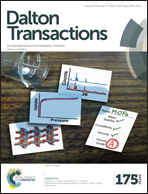Water-soluble, luminescent ZnTe quantum dots: supersaturation-controlled synthesis and self-assembly into nanoballs, nanonecklaces and nanowires†
Abstract
A supersaturation-controlled aqueous synthesis route has been developed for ZnTe quantum dots (QDs) with high monodispersity, size tunability, stability, band-edge luminescence (full-width at half-maximum (FWHM) 10–12 nm) and negligibly small Stokes’ shift (2–4 nm). The degree of supersaturation of the initial reaction mixture was varied by increasing the reagent concentration, but keeping the molar ratio Zn2+ : thioglycolic acid : Te2− constant at 1 : 2.5 : 0.5. For a 10× increase in supersaturation, the photoluminescence (PL) peak underwent a 50 nm blue shift from 330 to 280 nm at pH 6. The effect was more pronounced at pH 12, where the PL peak blue-shifted by 100 nm from 327 to 227 nm. Concomitantly, the FWHM was also reduced to a low value of 10 nm, indicating high monodispersity. For a 10× change in supersaturation, the particle size decreased by 63% (from 2.2 to 0.8 nm) at pH 12, whereas it changed by 19% (from 2.1 to 1.7 nm) at pH 6. High-resolution transmission electron microscopy and selected area electron diffraction data further revealed that the QDs synthesized at higher supersaturation had a better crystallinity. These QDs exhibited the unique property of undergoing isotropic and anisotropic self-assembly, which resulted in a blue shift and a red shift in the absorption and PL spectra, respectively. Isotropic assembly into spherical nanoballs (100 nm diameter, 1 nm inter-QD separation) occurred when the QDs were stored at pH 12 for 3 weeks at room temperature. The nanoballs further self-assembled into a ‘pearl necklace’ arrangement. On the partial removal of the capping agents, the QDs self-organized anisotropically into nanowires (1.3 μm long and 4.6 nm in diameter). The self-assembled nanostructures showed exciton–exciton coupling and excellent PL properties, which may be useful in enhanced optoelectronics, photovoltaics and biochemical sensing.



 Please wait while we load your content...
Please wait while we load your content...